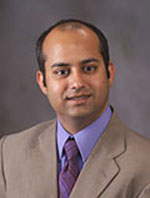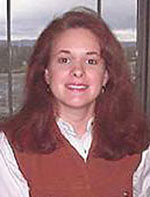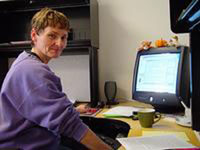The new unit will oversee the Black Cultural Center and Multicultural Center (located in Squires Student Center), cultural-awareness programs, advising for multicultural student organizations (Black Student Alliance, Asian American Student Union, Latino Association of Student Organizations, and Lesbian, Gay, Bisexual, Transgender Alliance), education and research, advocacy, and recruitment and retention.
In its first year, Multicultural Programs and Services will focus on cultural celebrations, entertainment, film series, lecture series, and awareness of such things as disabilities and the Holocaust.
Multicultural Programs and Services also will work with faculty to help them infuse multiculturalism into their classes. Besides providing multicultural support, Multicultural Programs and Services will educate other students, faculty, and staff about multicultural programs on campus, where programs can be part of the academic and intellectual development of the 26,000 students and more than 5,000 faculty and staff.
"We want Multicultural Programs and Services to be fully integrated into the life of the campus, not marginalized or separate," Sanders said. "We want to serve the entire Virginia Tech community."
A new director of Multicultural Programs and Services will be hired and will report to Sanders. An assistant director for advising, an assistant director for programming, a coordinator of academic support (who will be shared with the Center for Academic Enrichment and Excellence), as well as those to provide office and technical support, graduate assistants for programming and advising, and work-study students will round out the staff. Personnel from the merging areas will fill most of those positions.
Multicultural Programs and Services was established following the consolidation of several positions that were a part of the Division of Student Affairs. Specifically, the assistant director of cultural programs (formerly in Student Activities) and the coordinator of multicultural programs (formerly in the Student Life Office), will become a part of Multicultural Programs and Services. The new unit will be a part of the Division of Academic Affairs.
NEW RIVER VALLEY AMONG AMERICA'S SUPER CITIES OF THE FUTURE
by Sally Harris
 The Blacksburg/Christiansburg/Radford area is among the communities cited in Expansion Management magazine's third annual "Knowledge Worker Quotient," a designation that "identifies metro areas that are exceptionally well placed to attract and nurture high-tech companies and entrepreneurs because of their concentration of extremely well-educated workers."
The Blacksburg/Christiansburg/Radford area is among the communities cited in Expansion Management magazine's third annual "Knowledge Worker Quotient," a designation that "identifies metro areas that are exceptionally well placed to attract and nurture high-tech companies and entrepreneurs because of their concentration of extremely well-educated workers."
In the accompanying article, "America's Super Cities of the Future," the Blacksburg/Christiansburg/Radford area placed second in the category of "Top Metros: Ph.D.s Per Capita," following only Ithaca, N.Y. The area also placed 14th in the category of "Best Educated Technical Work Force." Blacksburg/Christiansburg/Radford also made the list of "Five-Star Knowledge Worker Metros."
"Clearly," the story by Chief Editor Bill King and Senior Research Editor Michael Keating said, "having a well-educated work force--engineers, scientists, Ph.D.s--in proximity to a major university, with its world-class faculty and buckets of R&D [research and development] dollars, is a major drawing card for technology-driven companies in the Knowledge Economy."
The full article can be found on Expansion Management magazine's website at http://www.expansionmanagement.com/smo/articleviewer/default.asp?cmd=articledetail&articleid=16423&st=2
NATIONAL ACADEMY INVITES RESEARCHER TO FRONTIERS OF ENGINEERING
by Liz Crumbley
Sandeep Shukla, an assistant professor in the Bradley Department of Electrical and Computer Engineering at Virginia Tech, is among 88 of the nation's outstanding young engineers invited by the National Academy of Engineering (NAE) to participate in the 11th annual Frontiers of Engineering Symposium, Sept. 22-24 at the General Electric Research Center in Niskayuna, N.Y.
 Shukla and the other attendees--engineers 30 to 45 years of age and representing academia, industry, or government--were nominated and selected in recognition of their contributions to the advancement of engineering and their potential as future leaders in their fields.
Shukla and the other attendees--engineers 30 to 45 years of age and representing academia, industry, or government--were nominated and selected in recognition of their contributions to the advancement of engineering and their potential as future leaders in their fields.
Shukla, who came to Virginia Tech in 2002, is a leading researcher in designing, analyzing, and predicting performance of electronic systems, particularly systems embedded in automated systems. In September 2004, he was honored at the White House as a recipient of a Presidential Early Career Award for Scientists and Engineers (PECASE), which is the highest national honor for researchers in the early stages of their careers.
"The computing world is moving from the desktop and workstation to an arena of embedded and wearable computers," Shukla said. More and more, embedded computers are becoming the brains behind mechanisms that we rely on in our everyday lives--such as wireless devices, cars, automated elevators, climate control systems, traffic signals, and washing machines. Embedded computers also constitute the backbone of our complex systems, including space mission controls, avionics, and weapons systems.
In 2003, Shukla and a group of colleagues in electrical and computer engineering, computer science, and mathematics founded the Center for Embedded Systems for Critical Applications with the goal of moving Virginia Tech to the forefront of research and education in the area of embedded systems.
Shukla received his bachelor's degree in computer science and engineering from Jadavpur University in India and his master's degree and Ph.D. in computer science from the State University of New York at Albany. He began studying embedded computers while working as an engineer with Verizon and, later, Intel. Before coming to Virginia Tech, he was a member of the research faculty of the Center for Embedded Computer Systems at the University of California at Irvine.
Frontiers of Engineering participants will hear presentations from the world's leading engineers and scientists on the topics of ID verification technologies, the engineering of complex systems, engineering for developing communities, and energy.
"Significant advances in engineering are occurring where disciplines intersect," said NAE President William A. Wulf. "Frontiers of Engineering provides an opportunity for engineers to learn about techniques and challenges in areas other than their own. This new knowledge can spark insights and collaborations that might not have occurred otherwise."
This year's symposium is sponsored by the NAE, General Electric Co., the Air Force Office of Scientific Research, the U.S. Department of Defense (DDR&E–Research), DARPA, Microsoft Corp., and Cummins Inc., as well as individual donors.
The National Academy of Engineering is an independent, nonprofit institution that serves as an adviser to government and the public on issues in engineering and technology. Its members consist of the nation's premier engineers, who are elected by their peers for their distinguished achievements. Established in 1964, NAE operates under the congressional charter granted to the National Academy of Sciences in 1863.
RESEARCHER SEEKS TO DISCOVER WHAT REALLY HAPPENS WHEN A VIRUS ENTERS THE BODY
by Lynn Nystrom
A well-respected researcher who is now a chief of an immunology laboratory of the National Institutes of Health (NIH) has rocked the boat in the past few years for the experts in the understanding of the autoimmune system.
NIH's Polly Matzinger has developed the "danger model," suggesting that the immune system is more concerned with damage detected on the basis of a biological cell's death than with the introduction of foreign invaders, such as viruses. If Matzinger is correct, then decades of scientific and medical diagnostic thinking could be in jeopardy.
As immunologists consider the relatively new concept, a new NIH grant, awarded to Amy Bell, an electrical and computer engineer (ECE), and Karen Duca, a research assistant professor at the Virginia Bioinformatics Institute (VBI), both of Virginia Tech, could answer some of the questions about the human body's responses to viruses. Viruses cause a number of diseases, from the common cold, to herpes, to AIDS. Even some types of cancer have been linked to viruses.
 Amy Bell Amy Bell
|
 Karen Duca Karen Duca
|
|
Prior to Matzinger's model, the common assumption was that the body's cells recognize substances or germs that do not come from within the body. The recognition triggers the immune system's attempt to eliminate the invader. What the immune system actually does, according to Matzinger, is discriminate between things that are dangerous and things that are not. And it does this by defining anything that does damage as dangerous. Through this selectivity process, the immune system does not respond to things that don't do damage. Examples she uses to support her thesis that the body recognizes some invading substances are not dangerous include the development of a fetus during a woman's pregnancy and the production of milk by lactating women. |
So the question remains: do we really know what a body's host cell does when a virus infects it?
Bell and Duca's collaboration is an attempt to profile the host-virus system using the electrical engineering concepts of signal and image processing. As Duca, a biophysicist, introduces viruses into cells in a laboratory dish, she infects only the cell's center. Then, she and Bell, who is also currently associated with VBI as one of its faculty fellows, study the response as the virus moves outward. Their method differs from conventional laboratory studies of viruses that generally involve infecting the entire dish at once.
As the virus moves out from the center in its attempt to infect other healthy cells, Duca identifies and stains relevant markers from the virus and the host. Under ultraviolet lighting, the chemical stains become fluorescent, allowing Bell and Duca to capture images of the laboratory dish at regular time intervals as the infection progresses. The images then provide Bell and Duca with information about innate immune responses to viruses.
Using the NIH support of almost $400,000, Bell plans to next remove the noise from these low-resolution images, creating what she calls a clean immuno-fluorescent intensity signal. The noise she refers to is not audible to the human ear. From an electrical engineering standpoint, noise in this example includes the spurious artifacts that appear in the image due to the microscope’s uneven source illumination. Noise can also result from the spectral overlap of the fluorescent markers that Duca uses.
Also, since the microscope cannot capture the entire laboratory dish at once, multiple sub-images must be taken quickly, then reassembled in the proper matrix. The "montage" artifact arises from the microscope's uneven illumination, which is brighter in the center and dissipates nearer the edges of the dish for each sub-image.
To compensate for this artifact or noise, Bell's lab has developed "a method to remove the grid created by assembling the montage of sub-images. Our method--based on a model we developed that reflects the physics of fluorescent microscopy--also estimates and corrects the effect of the microscope's uneven illumination and the markers' spectral overlap," Bell explains.
As Bell and Duca are able to develop their composite images, they will be able to mathematically produce a quantitative description of the spreading of the virus as well as the host-virus interaction. "The immuno-fluorescent intensity signals (IIS) depict how the virus and host are interacting over time, from the point of origin to the point of infection," Bell says.
Ultimately, the interdisciplinary team hopes their efforts will provide a quantitative method that derives a characteristic profile or fingerprint from the IIS of any host-virus system. If their method can achieve results in hours instead of days, their techniques could be used in clinical and field settings to quickly identify known viruses, or to map unknown viruses to existing profiles to better predict their behavior and start appropriate treatment.
Ultimately, their work should contribute to what starts an immune response. And as NIH's Matzinger says, knowing what initiates an immune response will affect and, researchers hope, improve medical treatment.
Bell is an associate member of the Virginia Tech-Wake Forest University's School of Biomedical Engineering and Science (SBES). SBES research focuses on imaging and medical physics, as well as biomechanics and cell and tissue engineering. Imaging has the invaluable potential to greatly extend the reach of medical research beyond detecting the anatomical presence of the disease. Employing applied engineering technologies to treatment will allow more intensive study of diseases at the cellular level. A greater understanding of the physiology of an illness will lead to more targeted treatments.